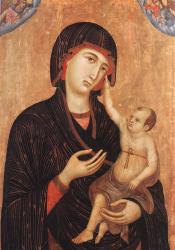Duccio's Madonna and Child with Two Angels
Duccio di Buoninsegna's rendition of the classic piece Madonna and child displays the changing paradigms of Byzantine and Renaissance art. Returning to the idea of anagogic space, Duccio makes use of the gold background and angels in the upper corners to maintain the Byzantine ideals of religion being set about the material world. However, he does drop the two-dimensional halos so often found in Byzantine artwork. The gold background does detract from the Renaissance ideals of realism and depth, but Duccio manages to encompass an emotion within the expression and movements of the woman and child that is rarely seen within Byzantine art. Their faces, extremely individualized as compared to previous style, represent a more affectionate relationship as one might see between a mother and child than can be seen in the traditional Madonna and Child which focuses more on religious symbology than on any form of realism. Duccio's combination of new and old ideals displays how he was painting in the midst of this shift in paradigms, and how often times changing art styles is an exceedingly long process which often has reversions to old practices and values.
Sources:
Belting, Hans. “The ‘Byzantine’ Madonnas: New Facts about their Italian Origin and Some Observations on Duccio.” Studies in the History of Art 12 (1982): 7-22. JSTOR. Web. 25 Feb. 2018.
Stubblebine, James H. “Byzantine Influence in Thirteenth-Century Italian Panel Painting.” Dumbarton Oaks Papers 20 (1966): 85–101. JSTOR. Web. 25 Feb. 2018.
Image Source:
Image courtesy of https://www.wga.hu/html_m/d/duccio/various/2crevole.html

